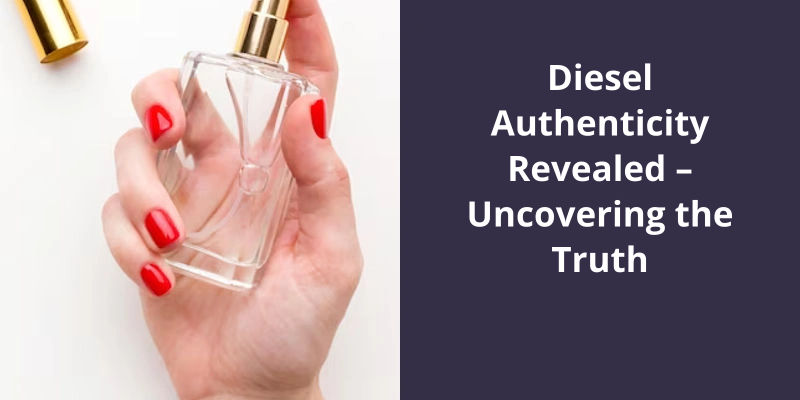Uncovering the truth of Diesel authenticity involves understanding the brand’s origin, quality, and unique style. Diesel is a renowned Italian retail clothing company founded in 1978, highly regarded for its premium quality and distinctive urban appeal. Genuine Diesel products such as jeans, fragrances, and other apparel are characterized by meticulous craftsmanship, durable materials, and innovative designs. Spotting a counterfeit Diesel product could be done by examining factors such as the price, product details, logos, tags, and buying from authorized dealers. Lower price than usual, incorrect logos, poor quality materials, and buying from unverified sources might tell you it’s a fake product. Therefore, to ensure Diesel authenticity, it’s important to purchase from trusted and official retailers.

How Do You Authenticate Diesel?
Diesel is a widely recognized brand in the fashion industry, known for it’s high-quality denim clothing and stylish accessories. However, with it’s popularity comes the unfortunate reality that counterfeiters often try to replicate the brands items and sell them as authentic. To combat this issue, Diesel has partnered with Certilogo, a company that offers a digital authentication service to protect consumers from purchasing fake products.
Through Certilogo, customers can verify the authenticity of their Diesel items by scanning a unique code on the label using the Certilogo app or website. This code is printed directly onto the clothing item, providing an added layer of security against counterfeiting. In addition to the code, the label will also include the slogan “Scan for Authenticity,” making it clear to consumers what they need to do to ensure they’re purchasing a genuine Diesel product.
The importance of authenticating Diesel products goes beyond just the financial aspect of purchasing a fake product. Counterfeit items can be of poor quality and even dangerous to wear, as they may not meet safety standards. Additionally, counterfeit products often support illegal activities such as human trafficking and organized crime. Therefore, it’s crucial for consumers to be able to confidently identify and purchase genuine Diesel products.
Tips for Spotting Fake Diesel Products
- Check the price. If it seems too good to be true, it probably is.
- Look at the quality of the product. Is the stitching straight and even? Are the materials high quality?
- Compare the product to authentic Diesel products. Look at the logos, fonts, and overall design.
- Beware of products sold on unauthorized websites or through unofficial channels.
- Check the packaging for misspellings or inaccuracies.
- Be wary of products that come with tags or labels that appear to be fake or not properly attached.
- Trust your instincts. If something seems off or suspicious, it’s better to err on the side of caution.
With a clear identity as an Outlaw archetype, Diesel’s brand positioning is as an edgy, rebellious alternative to the traditional luxury and high street fashion markets. Known for rejecting social norms and questioning the status quo, Diesel embodies a unique and distinct perspective in the fashion industry.
What Is the Brand Positioning of Diesel?
Diesel is a brand that’s managed to establish it’s own unique and unrivaled position in the fashion industry. The brands daring, bold and provocative identity has made it one of the most recognizable fashion labels in the world. Diesels brand identity is based on the rebellious and non-conformist attitudes of the youth culture from the 80s and 90s. The brands target audience is those who’re seeking to stand out from the crowd and make a statement.
Another factor that’s contributed to Diesels brand positioning is it’s association with music and other cultural influencers. Over the years, the brand has formed partnerships with some of the biggest names in the music industry, including David Guetta and Steve Aoki. These collaborations have helped to cement Diesels reputation as a brand that’s at the forefront of youth culture.
The History and Evolution of Diesel’s Brand Positioning
- Founded by Rudolf Diesel in 1913
- Originally focused on manufacturing diesel engines for industrial use
- Expanded into the automotive market in the 1930s
- Developed a reputation for producing reliable, high-performance engines
- In the 1950s, Diesel began to position itself as a premium brand
- Introduced the Diesel Only the Brave fragrance in 2008, signaling a shift towards fashion and lifestyle products
- Today, Diesel is known for it’s edgy, youthful aesthetic and innovative marketing campaigns
- Has faced controversy over the years for it’s provocative advertising and politically charged messaging
It’s important to know how to spot fake Diesel jeans and ensure that you’re purchasing an authentic Italian DIESEL product. One way to verify this is by checking for the heat-printed QR code that’s incorporated on the inside of the waistband of every pair. But are all Diesel jeans created equal in this regard? Let’s take a closer look.
Do All Diesel Jeans Have a QR Code?
This code is unique to each individual pair of jeans, and it can be scanned using a smartphone to verify it’s authenticity. This is a handy security measure that helps ensure that shoppers are getting the real deal when purchasing Diesel jeans. However, not all Diesel jeans have a QR code.
For starters, it’s important to note that not all styles and collections from Diesel will have a QR code. Some older styles may not feature a QR code, while newer releases are more likely to include one.
Additionally, it’s worth noting that the use of QR codes may vary depending on the region where the jeans are being sold.
If you’re specifically looking for Diesel jeans with a QR code, it’s a good idea to do some research ahead of time to determine which styles and collections are most likely to have them.
Some other things to look for include the quality of the fabric and stitching, the design of the label and branding, and the overall fit and feel of the jeans. Taking the time to do some research and inspect your potential purchase can help ensure that youre getting a genuine pair of Diesel jeans that youll love wearing for years to come.
Alternative Ways to Identify Authentic Diesel Jeans, Such as Tags and Labels
- Check the leather patch on the back of the jeans. It should have the Diesel logo and the words “Diesel Industry” printed on it.
- Look for the red tag with the Diesel logo on the left-hand side of the jeans. It should be attached to the belt loop.
- Inspect the white tag inside the jeans. It should have the style number and size printed on it, as well as the Diesel logo and the words “Made in Italy”.
- Verify the quality of the denim. Authentic Diesel jeans are made from high-quality, heavy-weight denim.
- Check the stitching. Authentic Diesel jeans have precise stitching and clean, even lines.
Now that we’ve a better understanding of the Diesel brand, let’s focus on identifying the model of Diesel jeans you own. There are a few key details to look for that can help you determine which model you have, and we will discuss them in the following sections.
How Do I Know What Model Diesel Jeans I Have?
If you’re unsure about the model of your Diesel jeans, it might be helpful to take a closer look at the label. Depending on the season or collection, there might be additional information about the style or fit of the jeans. For example, some labels might say “Slim Fit” or “Bootcut” to give you a better idea of the cut of the jeans.
Diesel has a distinctive aesthetic, and each collection has it’s own unique look and feel. By browsing through photos of current or past collections, you might be able to spot similarities or differences in the design details of your jeans.
It’s also worth noting that Diesel offers a range of washes and treatments for their denim. Some jeans might be distressed or have unique fading patterns that can help you identify them. Additionally, different washes might be associated with specific collections or styles.
Ultimately, while it can be frustrating not to know the exact model of your jeans, it’s important to remember that the most important factor is how they fit and make you feel.
Tips on How to Properly Measure Your Diesel Jeans to Determine the Size
Measuring your Diesel jeans is crucial to ensure the right fit. You can use a measuring tape to take accurate measurements around your waist, hips, and inseam. Always refer to the size chart provided by Diesel to determine the correct size for you. If you’re unsure about your size, it’s best to try on a pair in-store or order two sizes online and return the one that doesn’t fit.
In the following paragraphs, we will delve deeper into the history of Diesel and explore what the brand really stands for. From it’s unconventional approach to design and marketing to it’s socially-conscious initiatives, there’s much to uncover about this iconic fashion label. So, let’s dive in!
What Does Diesel Brand Stand For?
In the early days of the brand, Diesel was known for it’s unconventional designs and provocative advertising campaigns. They quickly gained a reputation for taking risks and pushing the boundaries of fashion. This bold approach captured the attention of young consumers who were looking for something different and unique.
One of the reasons Diesel became so successful was it’s ability to stay ahead of the curve. Renzo Rosso and his team were always looking to the future, seeking out new trends and technologies that they could incorporate into their clothing. This commitment to innovation and experimentation helped them stay relevant in an ever-changing fashion landscape.
Today, Diesel is known for it’s high-quality denim and edgy urban style. The brand has expanded to include a wide range of clothing and accessories for men, women, and children, but it’s commitment to pushing the boundaries of fashion remains a core part of it’s identity.
One of the most notable things about the Diesel brand is it’s commitment to sustainability. Renzo Rosso has long been an advocate for ethical and environmentally responsible practices in the fashion industry, and Diesel has taken numerous steps to reduce it’s impact on the planet. This includes using eco-friendly materials, promoting recycling and upcycling, and investing in renewable energy sources.
Conclusion
Throughout this investigation, it’s become clear that the authenticity of diesel fuel is a complex and nuanced issue. While there are many well-intentioned efforts to combat fraud and ensure that the fuel we use in our vehicles is safe and sustainable, the reality is that there are still many challenges to overcome. Factors such as supply chain complexity, globalization, and uneven regulatory enforcement all contribute to a murky landscape where authentic diesel fuel can be hard to come by. That said, it’s clear that there are steps that can be taken to improve the situation. By providing greater transparency and accountability throughout the supply chain, utilizing innovative technologies like blockchain and DNA fingerprinting, and empowering consumers with information about the products they purchase, we can begin to build a more trustworthy and sustainable system for diesel fuel. Ultimately, it will take the collective effort of industry, regulators, and consumers to ensure that we can all have confidence in the authenticity of the diesel fuel we rely on every day.





